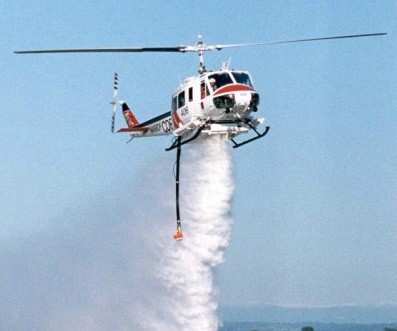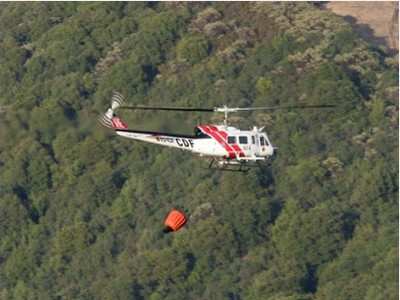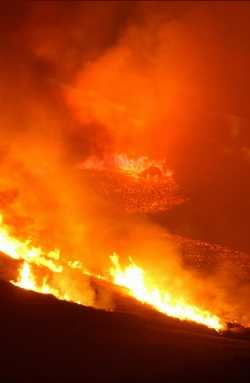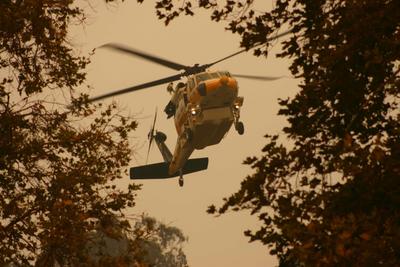Considered More Effective... But 1977 Collision Makes
Decision Difficult
There are times in California's Los Angeles County when
helicopter pilots are called upon to battle wildfires at night...
and at least two agencies are now considering bringing night water
drops to the Inland area.

"We've been working on it for the last year or two," Chief Mike
Padilla said of The Department of Forestry and Fire Protection --
also known as Cal Fire -- study of how night water drops might be
made by his statewide helicopter fleet, according to The
Press-Enterprise.
"LA County Fire Department is probably the most experienced
agency in night firefighting," Padilla said. "We're talking to them
... and assessing what we want to do."
Cal Fire currently has 11 Vietnam War-era military-surplus
helicopters and preliminary evaluations may be made with one or two
of those. But, a true full-scale program would require newer and
specially equipped helicopters and would take at least three or
four years to acquire and implement, Padilla said.
Cal Fire is responsible for fire protection on state lands and
also serves as Riverside County's fire department.
Every fire season, one of San Bernardino County Sheriffs
Department's 11 helicopters is assigned full-time to daylight
firefighting duty under a contract with Cal Fire. Their 15
helicopter pilots and supervisors have been talking about making
nighttime water drops.
"We have the ... ships, the night-vision goggles, the (water)
buckets and pilots," Lt. Tom Hornsby said. "So from the policy
decision to do it, it would take us two months (to develop
guidelines and to train an initial group of pilots). But that would
be hard-charging. And then we'd have only three or four pilots to
drop water at night on goggles."
He estimates another nine months would be required to train the
remaining pilots and emphasizes that no policy decision has been
made yet for sheriff's pilots to do nighttime firefighting.

Then there's cost. Is the department willing to risk its pilots
and spend $100,000 or more on equipment and training? Hornsby
said that question remains unanswered.
Officials agree the decision depends, in part, on whether the
benefits are worth the risks to pilots, who would be flying low
over unpredictable fires, surrounded by wires and other
obstructions, and doing it all in the dark.
"The benefit of (night water drops) is: Fire isn't as intense at
night so you can get a greater effect from your water dropping,"
said Chief Bill Smith of the Running Springs Fire Department in the
San Bernardino Mountains.
How to make the drops and maintain the safety of the pilots is
still the primary concern. In July 1977, two helicopters collided
while preparing to land at a reloading point in the Angeles
National Forest on a water-dropping mission. Both pilots were using
night-vision goggles; one pilot perished, the other was critically
injured.
 "That pretty much put a damper on
any night flying," recalled Smith, a US Forest Service retiree.
"That pretty much put a damper on
any night flying," recalled Smith, a US Forest Service retiree.
Forest Service spokeswoman Rose Davis said the agency no longer
conducts night water drops and has no plans to resume them. One of
the helicopters in the 1977 crash was a USFS helicopter.
The other helicopter was operated by LA County Fire Department.
Its crews put night-vision goggles down then and didn't pick them
up again until 2001 -- and then primarily for nighttime rescue
missions.
"It took us from 2001 to 2005 flying goggles in our area until
we felt comfortable doing night firefighting," recalled Tom Short,
senior pilot for LA County Fire Department. "We did not just jump
into this."
Night-vision goggles work by amplifying existing light, from
starlight to streetlights. Pilots say they use the goggles on
nearly every night firefighting flight, but not necessarily during
a water drop.
"I'll flip the goggles up because I have enough light around the
fire to see," Short said. "It's when I'm going to and from my water
source that I'll use the goggles."
It's important for pilots to be familiar with an area in
daylight before they attempt night drops there, Short said. Ponds,
lakes and other water sources are often in an unlighted location
with wires nearby that are difficult, even impossible, to see from
the air even during the day.
For that reason, it's especially reasonable for Cal Fire to proceed
slowly and cautiously, he said.
"I think it's a very wise thing (for Cal Fire) to be wary ...
because of the large area in which their pilots respond. It's
impossible to have (detailed) knowledge of the whole state," said
Short, who had flown in Los Angeles County for about 10 years
before he attempted water drops there with night-vision
goggles.
As can be expected, pilots with military flight experience tend
to be the most comfortable with the idea of nighttime water
drops.
"I've got 300 or 400 hours in night-vision goggles ... with the
military," said Padilla, Cal Fire's top-ranking aviation official.
"The last time I flew them was in Bosnia in '99."
One of his current staff officers wore goggles in the Marine
Corps and has flown Marine One, the president's helicopter. The
sheriff's helicopter unit has three former military pilots who have
become the agency's night-vision goggle instructors.
Six of the San Bernardino County sheriff department's newest
helicopters are equipped to make night water drops. Its pilots have
been using the goggles since last year to fly at night on
patrols.

It takes time for a pilot to acclimate to night-vision goggles.
So, sheriff pilots use them on flights over urban areas then
progress to more difficult topographical areas. Remote desert areas
are particularly dark and mountainous terrains are especially
hazardous.
"We may add (rescue) hoist operations as the next mission," said
Hornsby. "And after that, firefighting -- or maybe not."
(Some photos courtesy California Department of Forestry and
Fire Protection)
 ANN's Daily Aero-Linx (04.13.24)
ANN's Daily Aero-Linx (04.13.24) ANN's Daily Aero-Term (04.13.24): Beyond Visual Line Of Sight (BVLOS)
ANN's Daily Aero-Term (04.13.24): Beyond Visual Line Of Sight (BVLOS) Airborne 04.09.24: SnF24!, Piper-DeltaHawk!, Fisher Update, Junkers
Airborne 04.09.24: SnF24!, Piper-DeltaHawk!, Fisher Update, Junkers Aero-News: Quote of the Day (04.14.24)
Aero-News: Quote of the Day (04.14.24) ANN's Daily Aero-Term (04.14.24): Maximum Authorized Altitude
ANN's Daily Aero-Term (04.14.24): Maximum Authorized Altitude






